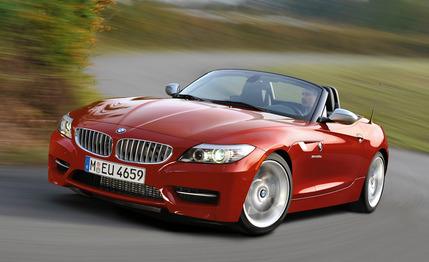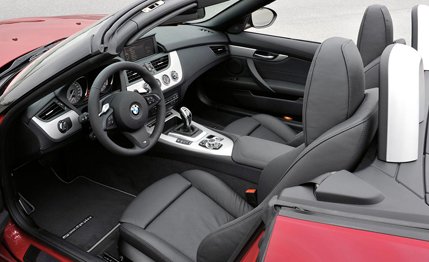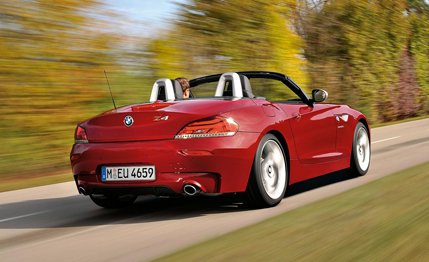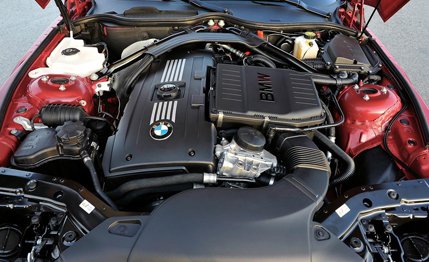 First Drive Review
First Drive Review
BMW has long made machines that embody its “Ultimate Driving Machine” motto, but some of its more recent products have been more emblematic of the company’s other, softer, and less focused tagline, “Joy.” For example, instead of a thrilling, satisfying roadster, the Z4 is a boulevardier more likely to be parked among a sea of beige luxury SUVs at the country club than spotted hustling over mountain passes. Given the brilliance of nearly every other BMW, the unfocused handling of what should be one of the company’s sportiest cars is even more of a bummer.
The clues are there in the folding hardtop, the electric hand brake, the light steering, and so on—the Z4 isn’t aimed toward enthusiast drivers. So what’s up with this sDrive35is model? It’s ostensibly the Z4 for those who want an Ultimate Driving Machine, so why throw more thrust—35 hp in this case—at a car that already has plenty and not fix the disappointing chassis? To charge more, of course, for what amounts to little more than some standardized options and what an aftermarket tuner could do with an ECU reflash.

Pump Up the Boost
It’s no coincidence that BMW announced its new 335is in the same time frame as it did the Z4 sDrive35is. That 3-series model and this Z4 are powered by an uprated and upgraded version of the sweet N54 3.0-liter twin-turbocharged inline-six. The N54 was good for 300 hp and 300 lb-ft in its previous, more ordinary applications, but all the “aye ess” cars receive software that cranks up the turbo boost, for a total output in the Z4 of 335 hp at 5900 rpm and 332 lb-ft of torque from 1500 to 4500 rpm. Mash your right foot to the floor, and a computer-controlled overboost function will provide a seven-second gust of 37 additional lb-ft of torque. If the engine computer is satisfied with turbo temperatures and other vital signs, the incremental torque boost can be accessed over and over again under wide-open throttle. The 335is makes 320 hp, down 15 from the Z4is because of more restrictive airflow, and the 3er gets an upgraded cooling system with an additional radiator and cooling ducts; this modification isn’t found on the roadster because BMW admits it doesn’t expect many owners to track their Z4s. The new seven-speed, dual-clutch automated manual (abbreviated DCT by BMW) is the only transmission offered on the Z4 sDrive35is.
The Cost of “is”
The Z4is starts at $61,925, some $7600 more than a Z4 sDrive35i with DCT. Part of that premium goes toward the engine upgrades, but the car also includes the M Sport package ($3500 on the 35i) that adds 18-inch wheels (19s are a further option), an adaptive M suspension, sport seats, a thicker M steering wheel, a body kit, and an increased top-speed limit of 155 mph. Moreover, Z4is buyers get a magnificent-sounding and specially tuned exhaust that sings a raspy melody best experienced with the top down, of course. A body-colored rear diffuser with sculpted exhaust surrounds and silver-colored mirror caps are unique to the Z4is.
Inside, the gussying up includes gray-faced gauges with “sDrive35is” logos, an anthracite-colored headliner for the folding hardtop, M door-sill badges, and “aluminum carbon” trim. Oh, and we can’t leave out the floor mats with colored piping and embroidered lettering.

Comparatively, spending almost $62,000 on a roadster also would get you the absolutely fantastic Porsche Boxster S equipped with a PDK automated-manual transmission. Another option is the Audi TTS roadster, and going that route means more than $12,000 stays in your pocket. Both cars—the Porsche in particular—offer sharper handling and are more rewarding to drive at the limit than any Z4.
Bad Behavior
In our previous experiences with the latest Z4, we’ve been impressed with its silhouette, fantastic power delivery, and smooth ride. We aren’t so keen on the disconnected feel and middling dynamics, and unfortunately, this sDrive35is is no different. When pushing the Z4is in the manner for which you assume it’s been designed, the suspension feels lazy and unenthusiastic, even in the most aggressive sport setting. Initial turn-in feels sharp, but head for the apex, and you’ll quickly experience a heavy dose of understeer. Meanwhile, the rear end is still catching up to your inputs, finally settling after an unnerving sway. It actually feels a bit like driving a bus or other long-wheelbase vehicle, where it takes time for what’s happening up front to reach the rear suspension. Needless to say, this behavior isn’t something that inspires much confidence in corners.

The electrically assisted steering feels diluted when compared with that of other BMWs, and although the DCT shifts ratios in the blink of an eye, the regular Z4’s extremely awkward steering-wheel-mounted push/pull shifters remain in the Z4is. When asked why the paddles weren’t changed to the more intuitive “pull right for upshift, pull left for downshift” setup seen in the 335is, BMW product specialists had no answer. Could it be that buyers of this car wouldn’t use them anyway, so adding them would hurt the Z4is’s profit margin?
The increased power makes for blistering straight-line speed and should shave 0.4 second from the 4.8-second 0-to-60-mph sprint of the Z4sDrive35i with DCT. But the extra quickness does little to alter the car’s laid-back personality, and given its history of building harmonious, satisfying drivers’ cars, BMW of all companies should have known this wasn’t the way to transform the Z4. Sure, the exhaust is rowdier, but there’s little substance to the “s” suffix here. BMW seemingly wants to increase its output of pricier special editions, à la Porsche—we just wish this one had started with a better foundation.